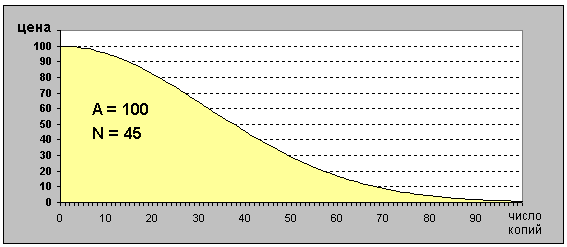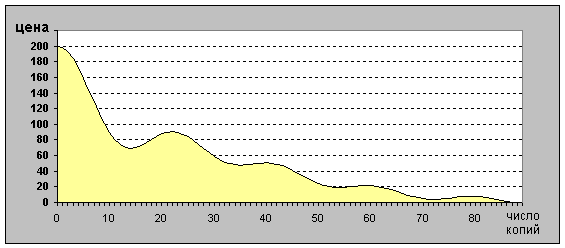Copyright from another galaxy

In one distant galactic galaxy there is a planet, a civilization on which has developed in a very unusual way. It just so happened that information technologies there have always been much better than material ones.
Concepts relating to intellectual activity were formed at the birth of society, since creative works were always in short supply. Real objects, on the other hand, have never been of great value to them. Therefore, the concept of trade in physical items is quite new, it is only a few hundred years old.
')
Everyone living on the planet knows that material objects are fundamentally different from non-material. Therefore, their prices are determined by one prime number and are not limited in time. While intangible - such as music, literature or cinema - are products of intellectual activity, therefore, their prices are intellectual, and are expressed by a function with two coefficients.
Of course, such a system would be unsuitable for our planet, however, it seemed interesting to me, so I decided to tell about it.
The price is determined by the formula established over many centuries of civilization:

where k is the copy number,
A is the starting price
N is the relaxation coefficient.
The graph of price changes depending on the number of the copy being sold is as follows:

When the price according to the formula falls below 1 monetary unit, the work goes into the public domain. The figure shows a variant with coefficients at which “planned” 100 potentially sold copies with an initial price of 100 money units are planned. Such a system was recognized as fair and consistent with the very nature of intellectual matter. At the beginning of sales, the price drops slightly, then a period of active decline occurs, and then the price gradually decreases to zero.
If this does not happen within the local year, the work goes into the public domain, regardless of how many copies were sold during the year. Therefore, sellers are interested to select such factors that the planned number of copies was sold earlier. If a famous author has created another masterpiece, he can rely on rather large A and N. Beginners, or those who work in the “not for all” genres, are content with a small planned number of copies, or a lower initial price.
Buyers, intending to buy something, see the current price and coefficients by which they can find out how the price change process is going. Although the number of the copy currently being sold is usually not indicated, it can always be calculated if desired.
Of course, it often happens that a seller who has appointed too large odds sells just a few copies by the end of the year, or, on the contrary, for an underestimated author, all planned copies go away in just a few weeks. Therefore, another condition was introduced: you can change the coefficients both in the one and in the other direction, but not more often than once a month. For example, after some time, making sure that the sale goes badly, the author decides to reduce the initial price, but to increase the relaxation coefficient, making the price reduction more smooth, hoping to sell more copies now.
Periodic processes associated with the monthly ability to change coefficients and the hype that arises with the approaching end of sales are very interesting and often become a topic for scientific work. For the seller, the best way is to choose a function so that the price disappears exactly by the end of the year. After all, by this time they buy inactively, knowing that it will soon be possible to copy for free, on the other hand the price is already close to zero. But to guess so is almost impossible. Therefore, the sellers adjust the schedule, trying not to bend it too high, but not too low, so that the copies are not selected for the next month, until it can change something again. This is true until the very last month, when it becomes clear to customers that, until the very end, the coefficients will not change.
Some feel that it is necessary to allow price changes at any time. The date of commencement of sales is usually known, so knowledgeable buyers follow the process, and it will always be possible to determine too cunning manipulators and simply not buy from them. Critics of such an approach argue that in this case the principle itself of a price gradually decreasing with time loses its meaning.
There is also an opinion that it is necessary to go further, and allow the sellers to determine the price change formula itself, so that it tends to zero. For example, one could choose a pure exponential or even damped oscillations, thus introducing a creative component in the behavior of buyers.

However, this approach has not yet found wide support, and the classical formula remains mandatory for all. Its features optimally self-regulate the process of rewarding creative activity. If the price seems high to buyers, they know that it decreases with each copy. However, if the copies diverge well and the price goes down too quickly, the seller may increase one of the ratios, or both, by the end of the month. There are people who want to get acquainted with the work as quickly as possible, and others who can wait. But there are always those who want to take the place of honor of the first buyers, connoisseurs, supporting creativity. It is prestigious to have one of the top ten or even hundreds of copies of a famous work, not to mention those who can boast of the first, most expensive copies.
Source: https://habr.com/ru/post/173483/
All Articles